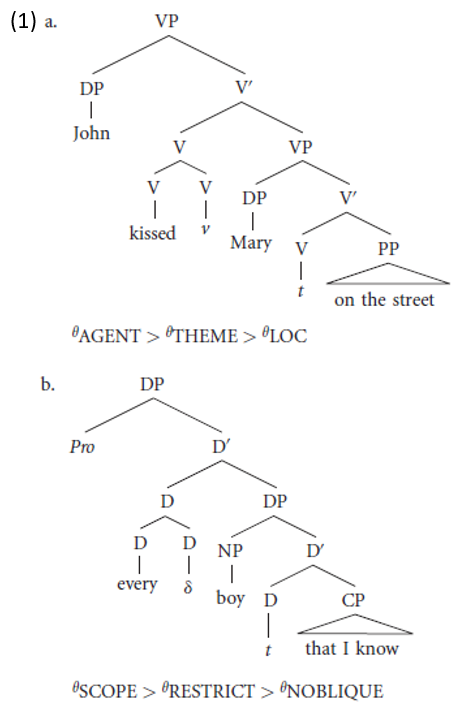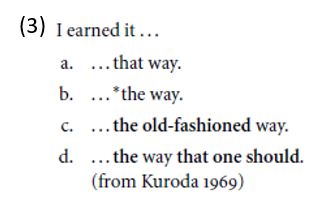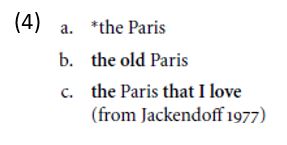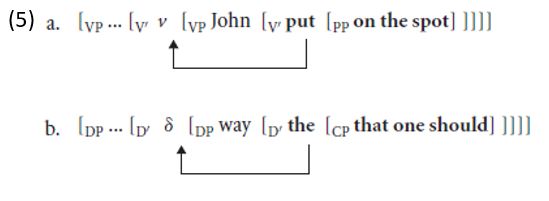


 Grammar
Grammar
 Tenses
Tenses
 Present
Present
 Past
Past
 Future
Future
 Parts Of Speech
Parts Of Speech
 Nouns
Nouns
 Verbs
Verbs
 Adverbs
Adverbs
 Adjectives
Adjectives
 Pronouns
Pronouns
 Pre Position
Pre Position
 Preposition by function
Preposition by function 
 Preposition by construction
Preposition by construction
 Conjunctions
Conjunctions
 Interjections
Interjections
 Grammar Rules
Grammar Rules
 Linguistics
Linguistics
 Semantics
Semantics
 Pragmatics
Pragmatics
 Reading Comprehension
Reading Comprehension|
Read More
Date: 2024-01-16
Date: 2024-01-06
Date: 2023-12-12
|
The position of modifiers
Within this general framework, verbal and nominal modifiers like those in (1) are not analyzed as adjuncts, attached high on the right, but rather as oblique complements, which actually combine with the head before other arguments.

This approach has a variety of advantages. For example, it allows us to capture certain discontinuous dependencies that appear to hold between the head (V or D) and a modifier. Thus (2a–d) give various cases in which a verb and an oblique PP form a notional unit that is discontinuous in surface syntax. (3a–d) and (4a–c) give familiar parallel cases for DP. The first is Kuroda’s observation that indefinite nouns like way are licit with a demonstrative determiner, but not with a simple definite; however, the combination of a definite determiner and a restrictive modifier are acceptable with such a noun. (4a–c), noted by Jackendoff, make a similar point in connection with proper nouns.



Under the shell theory both receive a similar treatment: the elements forming a notional unit comprise an underlying syntactic unit as shown in (23a, b); the latter is subsequently broken up when the overt head raises to the light head.1

1 The idea of relative clauses as semantic D arguments is first proposed (to our knowledge) by Bach and Cooper (1978), who suggest, within the framework of Montague Grammar, that alongside standard IL translations like (ia–c), Ds be assigned interpretations like (iia–c). Here R is a variable over properties that is filled in” by the denotation of an RC or other restrictive modifier.
(i) a. every ÎQÎP ∀x[Q(x) → P (x)]
b. some ÎQÎP ∃x[Q(x) → P (x)]
c. the ÎQÎP ∃y∀x[[Q(y) ↔ y = x] ∧ P (x)]
(ii) a. every ÎQÎP ∀x[[Q(x)&R(x)] → P (x)]
b. some ÎQÎP ∃x[[Q(x)&R(x)] → P (x)]
c. the ÎQÎP ∃y∀x[[[Q(y)&R(x)] ↔ y = x] ∧ P (x)]
|
|
|
|
دخلت غرفة فنسيت ماذا تريد من داخلها.. خبير يفسر الحالة
|
|
|
|
|
|
|
ثورة طبية.. ابتكار أصغر جهاز لتنظيم ضربات القلب في العالم
|
|
|
|
|
|
|
سماحة السيد الصافي يؤكد ضرورة تعريف المجتمعات بأهمية مبادئ أهل البيت (عليهم السلام) في إيجاد حلول للمشاكل الاجتماعية
|
|
|